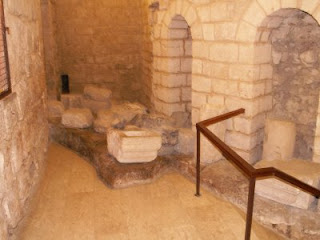Day 3 in Galilee
This was the day that we packed our bags and said good-bye to the Sea of Galilee to began our trek south. This was Valentines Day. But more importantly for the Jewish community, it was Shabat (Sabbath). This is the day that if we were in Jerusalem, we would've noticed a special elevator that stopped at every floor for the traditional Jews who adhered strictly to their Sabbath laws. There is no work on the Sabbath. This includes pushing buttons to go up and down the elevator. But as we would soon notice, there were many more secular Jews in Israel than Orthodox. This means that they weren't as strict.
The bus left
 Tiberias heading for Cana, Zippori, Nazareth, Megiddo and Ceasarea. Our travels in Cana brought us through an alley to the church that was built over the traditional site where Jesus turned the water into wine. Inside the church, we got to go down into the ruins. Being at the place where Jesus performed his first miracle (according to John's Gospel) was a treat.
Tiberias heading for Cana, Zippori, Nazareth, Megiddo and Ceasarea. Our travels in Cana brought us through an alley to the church that was built over the traditional site where Jesus turned the water into wine. Inside the church, we got to go down into the ruins. Being at the place where Jesus performed his first miracle (according to John's Gospel) was a treat.Next came Zippori. This was a major city in Jesus' time that was called the "Ornament of Galilee". Herod Antipas put his capital here for a time, before moving it to Tiberias. It was a city that probably had roughly 40,000 people in it. You might say it was the "big city" for Jesus, for he grew up in Nazareth, which in comparison was only about 150 people, and was only 4 miles away. The bible never mentions Jesus traveling to Zippori, but how could he not? As a carpenter in a small village, he'd need to go outside for work. Plus, as a kid, who could resist going into the city? I'm sure he traversed the streets of Zippori at some point or another and maybe even sat in the huge theater where we sat and learned about the city.
Next stop, Nazareth. The Church of the Annunciation was built over the traditional site of Mary's home, which was a cave. This church commemorates the visit of the angel. After Nazareth was Megiddo. We walked through the underground aqueduct and out of this city that had 26 different levels of occupation throughout its history. This is also known as Armegeddon, where many believe the last battle will be fought.
Before going to our final stop for the day, we needed a quick lunch. So where do you think we went? McDonald's, of course. But it wasn't as quick as we'd hoped and by the time we got to Caesarea, the open theater was closing. But we drove down the road just a little ways and got out on the beach and into the Mediterranean Sea and watched the sun go down. Yet, another beautiful sight to give thanks to God for.

This was known as Caesarea Maritimal, meaning by the sea. The name Caesarea comes from Caesar, whom Herod named the city after. The Roman theater that we got to sit in for a couple of minutes before being kicked out seated about 5,000 people. And the city probably had about 50,000 in all. The city's harbor was man made and a true building achievement that made Caesarea a powerful city. Ironically, it also is the harbor that would've take the Gospel into the world. It is also the harbor that would've cast Paul's boat out to Rome for the final time.
As this day wound down, we arrived at Jerusalem and The Olive Tree Hotel. This would be our home for the next several days.
In the love of Christ,
greg


0 Comments:
Post a Comment
<< Home